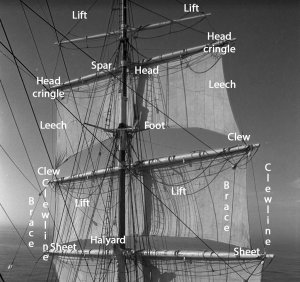English: Edges and corners of a square sail are shown on the uppermost sail:
- The sail is attached to a spar (or yard) at its head and tensioned outwards at the head cringles.
- The side edges are the leeches.
- The bottom edge is the foot and is attached to the yard below by sheets (not labelled) at the clews which are the corners.
- The lifts are shown slack, because the spar (or yard) is raised, but would support the lowered spar, as shown on the topmost spar.
- The sheets pull the clews down to the yard below when setting sail.
- The clewlines raise the clews to the yard above when dousing (striking or furling) sail.
- The halyard raises a yard into place, seen as two line converging on a block, which is attached to a line that goes up to the crosstrees and through a sheave to raise the yard.
- The braces adjust the sail side-to-side by tension applied from below to a block on the spar, countered by tension at the other end on a mast behind the spar, pulling one end aft and allowing the other end to rotate forward.
- Biddlecombe, George (1990) The Art of Rigging: Containing an Explanation of Terms and Phrases and the Progressive Method of Rigging Expressly Adapted for Sailing Ships, Dover Maritime Series, Courier Corporation, pp. 155 ISBN: 9780486263434.
- Underhill, Harold A. (1969) Masting and Rigging the Clipper Ship & Ocean Carrier: With Authentic Plans, Working Drawings and Details of the Nineteenth and Twentieth Century Sailing Ship, Glasgow: Brown, Son and Ferguson, pp. 304 ISBN: 0851741738.




